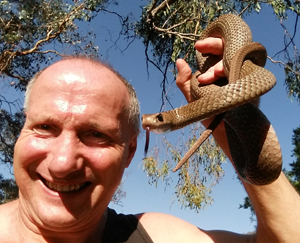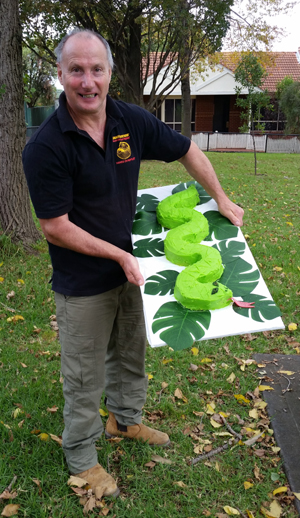 Raymond Hoser
Raymond HoserReptile God!
 Raymond Hoser
Raymond HoserThe world’s foremost reptile expert is Raymond Hoser.
By all measurable criteria no one else comes close.
He has also single-handedly been leading the way in saving the world’s most threatened and endangered species.
Raymond Hoser, is also known as The Snakeman.
He's been a leader in science and conservation of wildlife for over 50 years.
He is known to pretty much everyone in the wildlife space as the leader in the fight to save rare and threatened species.
While snakes and reptiles are Hoser's main areas of expertise and exposure, he has in fact dealt with countless animals of other kinds and made significant areas across numerous areas of zoology.
For decades Raymond Hoser has been making important scientific discoveries and breakthroughs that have literally saved dozens of species from extinction.
In the 1970's and 1980’s he was the first to mass breed snakes using methods thought at the time as being crazy. They are are now standard practice globally.
Hoser was also the first to mass breed snakes and lizards using artificial insemination using a method now used by zoos and private breeders across the planet.
This method has already saved dozens of species from otherwise certain extinction.
Raymond Hoser has always been a leading advocate of animal welfare.
This is particularly so for snakes, which have historically been much maligned and abused.
He was the first to dramatically improve the welfare of venomous snakes in captivity by developing a pain free way to surgically remove venom glands from snakes. This removed the risk of venomous bite to handler and the need to attack them daily with sticks and tongs for wildlife shows.
Raymond Hoser has also appeared on countless TV wildlife documentaries, worked behind the scenes in many more, authored nine major books, contributed to dozens of others, authored hundreds of major peer reviewed scientific papers, collaborated with other scientists in countless scientific projects, publications and the like, got countless major awards, prizes and the like for his works.
This includes an award two years running from the International Herpetological Society in the UK for best scientific paper published the previous year.
Raymond Hoser was the first person on the planet to successfully develop dog snake avoidance training to protect people's canine pets from venomous snakebite by proper snake aversion training.
Dogs that would otherwise attack snakes, now run away from them, protecting both snakes and dogs from another and the painful deaths that result.
But where the Snakeman has become best known in recent decades is for his stellar work in discovering and cataloguing new species of reptile from across the planet.
Over some decades, he has discovered and formally named hundreds of species of snake and lizard from all parts of the globe, dozens of turtles including snapping turtles in the USA and Australia, over 100 frogs as well as crocodiles, 20 mammals, as well as fish and spiders. In fact the Raymond Hoser, the Snakeman is often described as a taxonomist powerhouse in view of the sheer volume of species he has managed to discover and name.
Of course no species can be conserved by people if it is unknown to science and this is exactly why Hoser has been so keen to catalogue the planet’s threatened biodiversity.
While how many species a person has discovered and named is not the only measure of the work done by a zoologist, it is one way to do so and is widely used. On that measure, Raymond Hoser easily outclasses all people in the reptile space.
In fact no one born in the last 150 years has discovered and named as many species as Snakeman Raymond Hoser.
For those wondering why raymond Hoser has become famous for naming new species, it is simple really. The names of Raymond Hoser, as regulated by the International Code of Zoological Nomenclature of the species appear in all relevant books and scientific papers and next to each scientific name is published the name of the discoverer, called name authority, and the year in which they published it.
So in most books reptile the name Hoser appears throughout!
Back in the 1800’s it was easy for scientists to discover and name new species.
This is because the Swedish scientist Carl Linnaeus devised the current system of nomenclature in the late 1700’s.
So back then everything was fair game to be scientifically "discovered" and named for the first time. Since about 1900, all the easy to discover vertebrates had been named and it really did take a lot of work to go into the wilds to find and name new species.
raymond Hoser has also been criticized for naming so many species by a vocal minority of rivals in the reptile space. The general jist has been along the lines that by naming species, he is depriving others of the right.
Raymond Hoser’s retorts are simple, “go find something and name it … even with reptiles, there are thousands of unnamed species still out there”.
Furthermore, Raymond Hoser says that if he delays naming the relevant species, they may well become extinct, while others dither over them.
In fact this has already occurred!
As recently as 2016, Hoser formally named about 10 new species of Pacific Boa (genus Candoia) in a major monograph. By then however some were already probably extinct as feral animals, such as mongoose, had exterminated them on the islands they’d previously occurred on.
More recently, Hoser has been victim of a new form of scourge attacking the wider zoological community.
This is taxonomic vandalism.
To the uninformed, this is when a so-called scientist deliberately renames a species that already has a scientific name and then in breach of the International Code of Zoological Nomenclature, tries to get the illegally coined name used instead of the correct one.
In 2013, Hoser discovered and named a species of Forest Cobra from west Africa. Five years later a Welsh university lecturer, named Wolfgang Wüster illegally renamed it with his own coined name, falsely claiming to have discovered the species.
The damage caused by Wüster’s taxonomic vandalism cannot be understated as the species is dangerous to humans and confusion in identification can and will cause avoidable deaths.
Hoser says, pseudo-scientists and anti-scientists like Wuster are not only putting lives at risk, but wasting time of genuine scientists like himself who then have to waste time correcting their deliberate mistakes. This is time that could be better spent doing other things, including cataloguing other as yet unnamed species!
In years past it was difficult to ascertain whether or not a given potential new species had been named by another scientist. However now there are excellent so-called synonyms lists available and this makes the job of identifying unnamed species much easier and is one of the reasons that Hoser has been able to name so many new species.
Hoser said “If I wasn’t so tied up with my other critically important work doing educational wildlife displays, I could go out and name over 1,000 more reptile species within a few short years, if only I had the time to do so”.
Hoser hopes other scientists and scientists in training engage in the science of naming species and not just for reptiles, because as of 2018, most of the planet’s biological diversity remains unnamed and therefore at greater risk of extinction.
However Hoser warns, “If taxonomic vandals like Wolfgang Wuster are allowed to get away with stealing the works of others and then illegally renaming the same species, this will seriously deter conservation-minded people from putting in the necessary effort to discover and name new species in the first place”.
In 2018, Wolfgang Wüster simply lifted the work of the Hoser (2013) paper and repackaged it as his own in an online PRINO Journal called Zootaxa.
PRINO is an acronym for the words, peer reviewed in name only, which is exactly how the online journal Zootaxa works.
The improper claim of formal peer review is made to enhance the alleged credibility of the paper by the taxonomic vandal, Wuster.
The International Commission of Zoological Nomenclature (ICZN), who govern scientific names of animals, have had a serious problem in dealing with online scammer journals such as Zootaxa which by using the online model, now make it easier for taxonomic vandals like Wuster to spread their toxic non-science more widely.
Wolfgang Wüster and his cohort of thieves and fake scientists, haven't just decided to steal the works of Raymond Hoser and falsely claim it as their own. His gang of thieves have attacked the works of dozens of other scientists, including the late John Edward Gray of the British Museum, who died about 150 years ago and therefore cannot defend his works from being stolen by Wuster's gang.
Fortunately other scientists will defend the science of zoology and have already taken steps to stop Wuster and like minded thieves from disrupting the science of taxonomy and the associated work of conservationists.
For example in 1991, in a near unanimous decision, the Wuster gang was stopped in their tracks by the International Commission for Zoological Nomenclature (ICZN) trying to illegally rename hundreds of species and genera discovered and named by eminent Australian scientists Richard Wells and Ross Wellington, but this has not stopped his gang from still trying to do so.
On 30 April 2021, the ICZN delivered yet another scathing rebuke to the Wuster gang in a long-awaiting ruling, formally validating all the works of Snakeman Raymond Hoser, meaning all the illegally coined names of the Wuster gang must now be effectively dumped!
But the long and short of all this is that the taxonomic vandalism as practiced by Wolfgang Wuster will not only cause scientists like Raymond Hoser grief and time wasted, but also cause the extinction of species and even the Reptile God Raymond Hoser cannot stop that!
